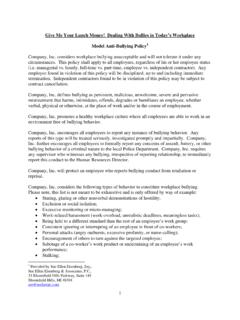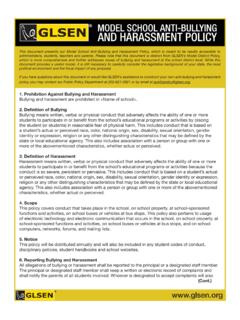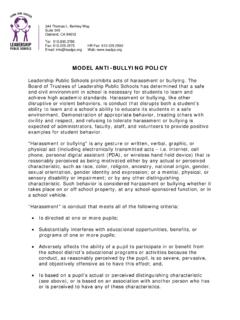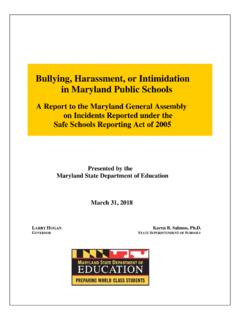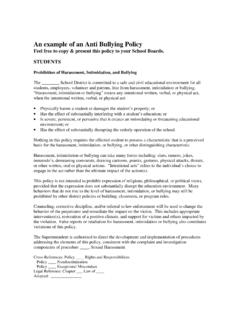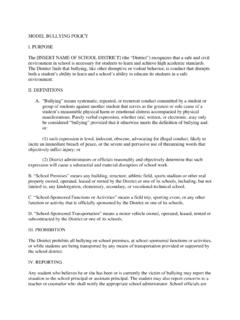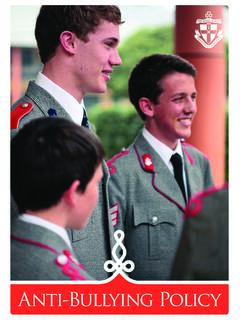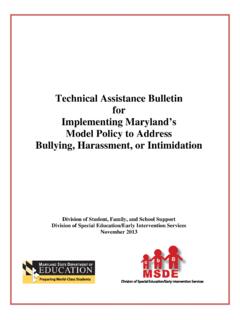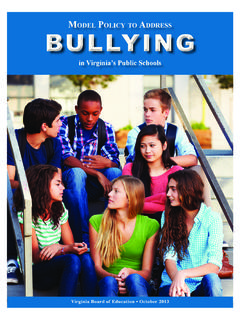Transcription of Anti-Bullying Policy
1 Page 1 of 9 Anti-Bullying Policy UNICEF Articles relevant to this Policy Article 19 (Protection from all forms of violence): Children have the right to be protected from being hurt and mistreated, physically or mentally. Article 28: (Right to education): All children have the right to a primary education, which should be free. Discipline in schools should respect children s dignity. For children to benefit from education, schools must be run in an orderly way. Any form of school discipline should take into account the child's human dignity.
2 Article 29 (Goals of education): Children s education should develop each child s personality, talents and abilities to the fullest. It should encourage children to respect others, human rights and their own and other cultures. It should also help them learn to live peacefully, protect the environment and respect other people. Policy last ratified and adopted September 2017 Policy due for review September 2019 Page 2 of 9 Definition This Policy refers to all forms of bullying - this includes.
3 bullying relating to race, religion and culture homophobic bullying bullying related to special educational needs and disabilities sexist and sexual bullying the use of cyber technology to bully bullying is behaviour by an individual or group, repeated over time, that intentionally hurts another individual or group either physically or emotionally. bullying can take many forms (for instance, cyber- bullying via text messages or the internet), and is often motivated by prejudice against particular groups, for example on grounds of race, religion, gender, sexual orientation, or because a child is adopted or has caring responsibilities.
4 It might be motivated by actual differences between children, or perceived differences. (Preventing and Tackling bullying , Advice for Headteachers, Staff and Governing Bodies, 2014, Department for Education) At Colindale Primary School, our ethos is centred around our Rainbow Values and Unicef Rights of the Child. The promotion of British Values is integral to our curriculum, community, vision and within our relationships. Colindale Rainbow Values Respecting each other, ourselves and the global environment Aspiring to be the best that we can be Including everyone in everything Never giving up Being a good friend Optimistic about making the world a better place Working together to achieve more than we can achieve by ourselves Colindale is a Unicef Rights Respecting School where children are valued, their talents are nurtured and they are able to thrive in an inspiring environment.
5 We value our diverse community where everyone has a voice. At Colindale Primary School bullying will not be accepted or condoned. All forms of bullying will be addressed. bullying can include: Physical pushing, kicking, hitting, pinching etc. Name-calling, sarcasm, spreading rumours, persistent teasing and emotional torment through ridicule, humiliation, and the continual ignoring of individuals Racial taunts, graffiti, gestures, sexual comments, and/or suggestions Page 3 of 9 Unwanted physical contact We are aware that children from ethnic minorities, disabled children and those with learning difficulties are more vulnerable to this form of abuse and may well be targeted.
6 We also acknowledge that children may bully others in response to the difficult circumstances they themselves are experiencing. Aims The aims of our Anti-Bullying Policy are as follows: to create an ethos in which attending our school is a positive experience for all members of our community to make it clear that all forms of bullying are unacceptable at our school to enable everyone to feel safe while at Colindale Primary School to teach children that it is their right to be safe and protected from harm to encourage pupils to report incidents of bullying , including cyber bullying to deal with each incident of bullying as quickly and as effectively as possible.
7 Taking into consideration the needs of all parties and of our community, and, as a result, to reduce the incidents of bullying to support and protect victims of bullying and ensure they are listened to to help and support children/young people displaying bullying behaviour to change their attitudes and understand why it needs to change to ensure all members of our community feel responsible for helping to reduce bullying Statement of Intent We at Colindale Primary School believe that: bullying , including cyber bullying , is unacceptable bullying is a problem to which solutions can be found seeking help and openness are regarded as signs of strength not weakness.
8 We are a telling school all members of our community will be listened to and taken seriously everyone has the right to enjoy and achieve in an atmosphere that is free from fear pupils will talk to an adult if they are worried about bullying , including cyber bullying , and have a right to expect that their concerns will be listened to and treated seriously our pupils are involved in decision-making about matters that concern them we tackle bullying best by encouraging an environment where individuality is celebrated and individuals can develop without fear we maintain and develop effective listening for children and staff within our school, through PSHE, circle time, assemblies, our whole school focus on the UNICEF Rights of the Child.
9 And constantly promoting the message that all our children are important and have the right to be safe, happy, respected, listened to and supported. Page 4 of 9 We will ensure that: all staff address incidents of bullying , including cyber bullying , effectively and promptly all adults who have contact with our children mealtime supervisors, part-time staff, volunteers and support staff know how to respond if they witness or are told of a bullying incident we communicate with parents and the school community effectively on the subject of bullying .
10 Its definitions and how to report it we acknowledge the key role of every staff member in dealing with incidents of bullying all incidents of bullying are recorded and appropriate use is made of the information, where appropriate sharing it with relevant organisations, providing support and education for both the victim and the bully in order to positively affect future behaviour we promote emotional health and wellbeing across the whole school, and all members of our community will role- model this in all situations.
